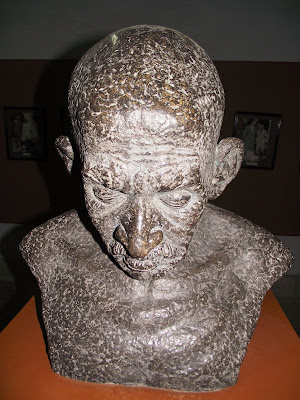 Tea planatation workers
Tea planatation workers Student art depicting Mother Theresa
Student art depicting Mother Theresa
Bust of Gandhi in Assam State Museum
“This blog is not an official U.S. Department of State website. The views and information presented are the grantee’s own and do not represent the Teaching Excellence and Achievement Program, the International Leaders in Education Program or the U.S Department of State.” (required disclaimer)
The TEA and IREX Programs under the sponsorship of the United States Department of State have allowed me the opportunity to grow professionally and learn in a very unique environment. I must confess that I am a “culture junkie.” As a child growing up in a small town in Alabama I read of far off places and dreamed of travel and experiences. I traveled to India and other exotic locations in my dreams and through literature only. On my business card I have this quote from St. Francis of Assisi: “Start by doing what’s necessary; then do what’s possible; and suddenly you are doing the impossible.” As a teaching professional I have been so fortunate to have the opportunity to live the seemingly impossible dream.
In my opinion exchange programs between educators are essential in the modern world. Isolation and ignorance must be overcome if we are to work together for peace and the mutual benefit of the students of the world. In my travels I have learned that we share so much more in common than we realize most of the time. Parents everywhere want their children to succeed in life and know that education is the path to improve their lives and circumstances. People want truth, justice and fairness in their daily lives and worry about the environment and the future of their countries. Foreign students have preconceived ideas of American life that are based on television coverage. I did my best to answer student and teacher questions and let them know that the media and reality TV programming does not represent the vast majority of American citizens. The streets of America are not paved in gold and we must all work to earn a living no matter where we happen to reside.
I use my travel experiences almost daily in the classroom. Students immediately pay closer attention when a personal story or anecdote is given in class. We all love a good story and to hear of personal experiences from people around us. This adds interest and complexity to the presentation of world literature and stimulates students to read more and travel themselves.
This is my closing IREX post, but I want to ask you to take the time to read the other six or seven entries under the IREX label. Because I am a “culture junkie” my best writing and reflections are on the culture of India: the food, the street life, fashion, religion and the Rhinos of Kaziranga National Park. I had such a rich experience and met so many wonderful people on this trip. I can honestly and sincerely report that the hospitality of the Assamese people of India is unparalleled in the WORLD!
Thank you to all the teachers, students and administration of Maharishi Vidya Mandir School for their hospitality and sharing of the Assamese and Indian culture. Thank you IREX for selecting me for this prestigious program and also special thanks to the U.S. Department of State for their foresight in sponsoring this teaching exchange.
Please read on………..
Please read on………..
















